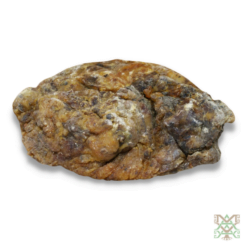Myrrh (Commiphora Myrrha) – Incense Resin Granules from Kenya
Desde € 7,14 Incl. VAT
Botanical name: Commiphora myrrha
Common name: Myrrha
Plant part: Resin
Form: Granules
Country: Kenya
For smaller weights, please see our Sacred Incense range.
Beschreibung
More about Myrrh (Commiphora Myrrha)
Top quality Myrrh resin wild harvested along the Kenyan/Somalian border. Infused with warm, musky, earthy and woody tones. Myrrh resin, said to be one of the gifts of the three wise men, has been used since ancient times as an incense.
Commiphora myrrha, Burseraceae (Copal family), is indigenous to Somalia, Ethiopia, Eritrea, Yemen, and South Arabia. A pale yellow oil drips from the cuts in its dull gray bark and hardens to form teardrop-shaped nuggets of Myrrh, which are powdered for use as an incense.
The bushes yielding the resin do not grow more than 30 cm in height, but they are of sturdy build, with knotted branches, and branchlets that stand out at right-angles, ending in a sharp spine. The trifoliate leaves are scanty, small and very unequal, oval and entire. The fruit is ovate, smooth, brown, somewhat larger than a pea, surrounded at base by a 4-toothed calyx, and supported on a very short stalk.
There are ducts in the bark, and the tissue between them breaks down, forming large cavities, which, with the remaining ducts, becomes filled with a granular secretion which is freely discharged when the bark is wounded, or from natural fissures. It flows as a pale yellow liquid, but hardens to a reddish-brown mass, being found in commerce in tears of many sizes, the average being that of a walnut.
The surface is rough and powdered, and the pieces are brittle, with a granular fracture, semi-transparent, oily, and often show whitish marks. The odor and taste are aromatic, the latter also acrid and bitter. It is inflammable, but burns feebly
Reviews (0)
Only logged in customers who have purchased this product may leave a review.



















Reviews
There are no reviews yet.